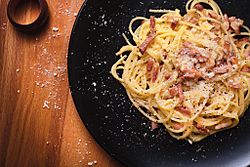Carbonara facts for kids

Spaghetti alla carbonara
|
|
| Course | Primo (Italian pasta course); main course |
|---|---|
| Place of origin | Italy |
| Region or state | Lazio |
| Serving temperature | Hot |
| Main ingredients | Guanciale (or pancetta), eggs, hard cheese (usually Pecorino Romano, Parmesan, or a mixture), black pepper, spaghetti |
| Variations | Using penne, or adding cream, garlic, or vegetables |
Carbonara (Italian: [karboˈnaːra]) is a super yummy Italian pasta dish. It comes from the city of Rome. The main ingredients are eggs, a type of hard cheese, cured pork, and black pepper. This tasty dish became popular and got its name in the mid-1900s.
The cheese used is usually Pecorino Romano or Parmigiano-Reggiano. Sometimes, cooks use a mix of both. While Spaghetti is the most common pasta for Carbonara, other types like fettuccine, rigatoni, linguine, or bucatini can also be used. For the meat, guanciale (cured pork cheek) or pancetta (cured pork belly) are traditional. Outside Italy, people often use bacon instead.
Contents
The Story of Carbonara
Just like many old recipes, the exact start of Carbonara is a bit of a mystery. But most people agree it comes from the Lazio region in Italy.
This dish is part of a family of pasta recipes that use cured meat, cheese, and pepper. One of these is pasta alla gricia. Carbonara is also very similar to pasta cacio e uova. This older dish used melted lard, eggs, and cheese. Some people think pasta cacio e uova was the old name for Carbonara before World War II.
Where Did the Name "Carbonara" Come From?
The name carbonara is probably newer than the dish itself. It comes from the Italian word carbonaro, which means 'charcoal burner'. Some people believe the dish was first made for Italian charcoal workers. It was a hearty meal to give them energy. In some parts of the United States, this idea led to the nickname "coal miner's spaghetti."
Another idea is that the dish was named after the Carbonari. This was a secret group in Italy in the early 1800s. But it's more likely that Carbonara is a "city dish" from Rome. It might have become famous because of a restaurant called La Carbonara in Rome.
The names pasta alla carbonara and spaghetti alla carbonara were not used before World War II. For example, a famous cookbook from 1930 called La Cucina Romana (Roman Cuisine) doesn't mention it. The name carbonara first appeared in 1950. An Italian newspaper said American soldiers looked for this dish after the Allied forces freed Rome in 1944. At that time, many Italians were eating eggs and bacon given by the American troops. In 1954, the recipe was included in an English cookbook called Italian Food.
How to Make Carbonara
Making Carbonara is fun! Here's how it's usually done:
- First, you cook the pasta in water that's a little bit salty.
- While the pasta cooks, you fry the guanciale (or pancetta) in a pan. You don't need extra oil because it cooks in its own fat.
- Next, you mix raw eggs (or just the yolks), grated Pecorino Romano cheese, and lots of ground black pepper.
- When the pasta is hot and ready, you add it to the egg and cheese mix. You do this away from direct heat. This is important so the egg doesn't scramble!
- Then, you add the fried guanciale.
- You toss everything together. This creates a rich, creamy sauce that coats the pasta. The little bits of meat are spread throughout.
- Long, thin pasta shapes like fettuccine, linguine, or spaghetti work best. This is because the raw egg can cook perfectly with these shapes.
Ingredients You Can Use
In Italy, guanciale is the most common meat. But pancetta is also used. In countries like the United States, bacon is often used instead. The usual cheese is Pecorino Romano. Sometimes, Parmesan is also used. Recipes can differ in how they use eggs. Some use whole eggs, some use only the yolk, and others use a mix.
Different Ways to Make It
Some Carbonara recipes have more sauce. For these, people might use penne or other tube-shaped pasta. These shapes are good at holding more sauce. Most traditional Italian recipes do not use cream. However, in other countries, cream is often added. Also, garlic is sometimes found in recipes, but mostly outside Italy.
Outside Italy, you might find Carbonara with other ingredients. These can include green peas, broccoli, leeks, onions, or mushrooms. Some recipes might even use ham or coppa instead of the fattier guanciale or pancetta.
Carbonara Sauce in Stores
You can often buy Carbonara sauce as a ready-to-eat meal in grocery stores. These store-bought sauces are different from homemade Carbonara. In a real Carbonara, the creamy sauce is made right on the hot pasta. But the store versions are already prepared sauces. You just add them to your cooked pasta. They might be thicker with cream or food starch. They often use bacon or cubed pancetta instead of guanciale.
See also
 In Spanish: Carbonara para niños
In Spanish: Carbonara para niños

